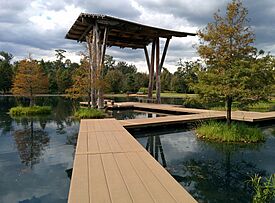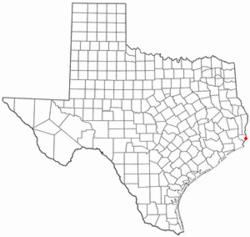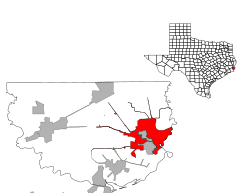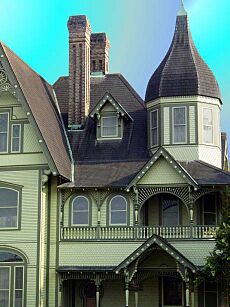Orange, Texas facts for kids
Quick facts for kids
Orange, Texas
|
|
|---|---|
 |
|
| Nicknames:
Gateway City, Gatecity, Fruit City
|
|
| Motto(s):
Small town charm, world class culture
|
|

Location of Orange, Texas
|
|
 |
|
| Country | United States |
| State | Texas |
| County | Orange |
| Community | 1830 as Green's Bluff |
| Renamed | 1840 as Madison |
| County seat | 1852 |
| Incorporated | 1858 as Orange |
| Government | |
| • Type | Council–manager |
| Area | |
| • Total | 21.456 sq mi (55.571 km2) |
| • Land | 21.352 sq mi (55.301 km2) |
| • Water | 2.104 sq mi (5.450 km2) |
| Elevation | 10 ft (3 m) |
| Population
(2020)
|
|
| • Total | 19,324 |
| • Estimate
(2022)
|
19,081 |
| • Density | 894.0/sq mi (345.0/km2) |
| Demonym(s) | Orangite |
| Time zone | UTC–7 (Central (CST)) |
| • Summer (DST) | UTC–6 (CDT) |
| ZIP Codes |
77630, 77631, 77632
|
| Area code(s) | 409 |
| FIPS code | 48-54132 |
| GNIS feature ID | 2411326 |
Orange is a city in Orange County, Texas, United States. It's also the county seat, which means it's where the main government offices for the county are located. In 2020, about 19,324 people lived there.
Orange is the easternmost city in Texas. It sits right on the Sabine River, which forms the border with Louisiana. It's about 113 miles (182 km) from Houston. Orange is part of the larger Beaumont−Port Arthur area. It was founded in 1836 and has a deep-water port that connects to the Gulf of Mexico.
Contents
History of Orange, Texas
The area where Orange is located was first known as Greens Bluff. It was named after Resin Green, a boatman who arrived there before 1830. In 1840, the town's name was changed to Madison, honoring President James Madison.
However, there was another town in Texas called Madisonville, which caused confusion with mail. So, in 1858, the town was renamed "Orange." In the late 1800s, Orange grew quickly because it had 17 sawmills. This made Orange a major center for the lumber industry in Texas. Many new people moved to Orange during this time. In 1898, a courthouse was built in the city.
Growth and Challenges in Orange
In 1914, the harbor leading to the Port of Orange was made deeper so that large ships could use it. During World War I, shipbuilding became very important, and the city's population and economy grew a lot.
The Great Depression in the 1930s was a tough time for the city's economy. But things improved during World War II. A U.S. Naval Station was built in Orange, and many homes were provided for defense workers and military families. The city's population grew to over 60,000 people. The USS Aulick was the first of 300 ships built in Orange during the war.
After the war, the population went down to about 35,000. The Navy decided to store some of its reserve ships in Orange because the Sabine River provided plenty of fresh water to prevent saltwater corrosion. Also, local chemical plants expanded, which helped the economy. The chemical industry is still a big part of Orange's economy today. The U.S. Naval Station closed in 2008.
The USS Orleck was a naval ship built in Orange during World War II. It became a museum ship in Orange. However, after Hurricane Rita hit in 2005, the ship was damaged. The city decided it needed to be moved. In 2010, the ship was moved to Lake Charles, Louisiana, where it opened as a museum in 2011.
Orange and Hurricanes
Orange has faced several powerful hurricanes over the years.
Hurricane Ike's Impact
On September 13, 2008, Hurricane Ike caused a lot of damage in Orange. A storm surge, which is a rise in sea level caused by a storm, was 22 feet (6.7 meters) high. This surge broke the city's protective walls (levees) and caused severe flooding. Almost the entire city of 19,000 people was flooded, with water levels from 6 inches (15 cm) to 15 feet (4.5 m) deep. Many people who stayed behind needed help with food, water, and medical care.
Hurricane Harvey's Flooding
Orange was hit by widespread flooding again when Hurricane Harvey arrived on August 29, 2017. Most of the floodwaters came from the rising Sabine River and its smaller rivers. The flooding from Harvey was due to extreme rainfall, with 50 to 60 inches (127 to 152 cm) of rain falling in just 48 hours. This left 65% of Orange County underwater. The Sabine River rose three days after the storm when floodgates at the Toledo Bend Reservoir were opened.
Geography and Climate
Orange covers a total area of about 21.456 square miles (55.571 km2). Most of this area is land, with a smaller part being water.
Orange's Climate
Orange has a humid subtropical climate. This means winters are usually mild and rainy, while summers are hot, humid, and wet. The weather is similar to nearby towns like Vinton, Louisiana, and Beaumont, Texas. The hottest temperature ever recorded in Orange was 105 °F (41 °C) on August 10, 1962. The coldest was 11 °F (−12 °C) on December 26, 1983. Orange gets about 60 inches (152 cm) of rain each year.
| Climate data for Orange, Texas | |||||||||||||
|---|---|---|---|---|---|---|---|---|---|---|---|---|---|
| Month | Jan | Feb | Mar | Apr | May | Jun | Jul | Aug | Sep | Oct | Nov | Dec | Year |
| Record high °F (°C) | 80 (27) |
82 (28) |
87 (31) |
91 (33) |
95 (35) |
98 (37) |
104 (40) |
105 (41) |
99 (37) |
93 (34) |
87 (31) |
82 (28) |
105 (41) |
| Mean daily maximum °F (°C) | 60 (16) |
64 (18) |
71 (22) |
77 (25) |
84 (29) |
89 (32) |
91 (33) |
92 (33) |
87 (31) |
80 (27) |
70 (21) |
63 (17) |
77 (25) |
| Mean daily minimum °F (°C) | 40 (4) |
43 (6) |
50 (10) |
56 (13) |
64 (18) |
70 (21) |
72 (22) |
72 (22) |
67 (19) |
57 (14) |
48 (9) |
42 (6) |
57 (14) |
| Record low °F (°C) | 15 (−9) |
21 (−6) |
24 (−4) |
34 (1) |
47 (8) |
52 (11) |
57 (14) |
58 (14) |
42 (6) |
35 (2) |
23 (−5) |
11 (−12) |
11 (−12) |
| Average rainfall inches (mm) | 6.01 (153) |
3.74 (95) |
3.90 (99) |
3.61 (92) |
5.70 (145) |
6.21 (158) |
5.34 (136) |
4.65 (118) |
5.60 (142) |
4.56 (116) |
4.62 (117) |
5.22 (133) |
59.16 (1,504) |
Population and People
| Historical population | |||
|---|---|---|---|
| Census | Pop. | %± | |
| 1860 | 936 | — | |
| 1890 | 3,173 | — | |
| 1900 | 3,835 | 20.9% | |
| 1910 | 5,527 | 44.1% | |
| 1920 | 9,212 | 66.7% | |
| 1930 | 7,913 | −14.1% | |
| 1940 | 7,472 | −5.6% | |
| 1950 | 21,174 | 183.4% | |
| 1960 | 25,605 | 20.9% | |
| 1970 | 24,457 | −4.5% | |
| 1980 | 23,628 | −3.4% | |
| 1990 | 19,381 | −18.0% | |
| 2000 | 18,643 | −3.8% | |
| 2010 | 18,595 | −0.3% | |
| 2020 | 19,324 | 3.9% | |
| 2022 (est.) | 19,081 | 2.6% | |
| U.S. Decennial Census 2020 Census |
|||
Orange's Population in 2020
| Race | Number | Percent |
|---|---|---|
| White (NH) | 9,502 | 49.17% |
| Black or African American (NH) | 6,795 | 35.16% |
| Native American or Alaska Native (NH) | 58 | 0.3% |
| Asian (NH) | 340 | 1.76% |
| Pacific Islander (NH) | 8 | 0.04% |
| Some Other Race (NH) | 58 | 0.3% |
| Mixed/Multi-Racial (NH) | 720 | 3.73% |
| Hispanic or Latino | 1,843 | 9.54% |
| Total | 19,324 | 100.00% |
In 2020, Orange had 19,324 people living there. There were 7,870 households and 4,966 families. The population density was about 905 people per square mile (349 people per km2). This means how many people live in a certain area.
Orange's Population in 2010
In 2010, Orange had 18,595 people. About 27.4% of the population was under 18 years old. The average age was 36 years. For every 100 females, there were about 92 males.
Economy
The Texas Department of Criminal Justice has a parole office in Orange.
Arts and Culture in Orange
Orange has several interesting places to visit.
- The Stark Museum of Art has a great collection of American Western art from the 1800s and 1900s. It shows the land, people, and animals of the American West. The museum also has Native American art, glass, porcelain, and rare books. You can see works by famous artists like John James Audubon and Albert Bierstadt.
- The W. H. Stark House is a beautifully restored Victorian home from 1894. It shows how a wealthy family in Southeast Texas lived. This large house has 15 rooms, three stories, and many unique features like gables and a windowed tower.
- The First Presbyterian Church on Green Avenue is a good example of classic Greek Revival architecture. It was finished in 1912 and was the first public building west of the Mississippi River to have air conditioning. Its dome is also the only one in the United States made of opalescent glass.
- The Confederate Memorial of the Wind is a monument being built on private land near Interstate 10.
Education
Several school districts serve the city of Orange, including Little Cypress-Mauriceville Consolidated Independent School District, West Orange-Cove Consolidated Independent School District, Orangefield Independent School District, and Bridge City Independent School District.
Lamar State College–Orange is a community college in the city. It is part of the Texas State University System.
Media
The Orange Leader is a newspaper that comes out twice a week in Orange.
Transportation
Getting Around Orange
Orange is served by Interstate 10, a major highway. It also has a deep-water seaport. For air travel, people can use the nearby Southeast Texas Regional Airport for commercial flights or the Orange County Airport for general aviation.
Orange has a unique feature on Interstate 10: exit 880. This is the highest numbered exit and mile marker on an interstate highway in North America. There's also a famous sign on westbound Interstate 10 that tells drivers it's 23 miles (37 km) to Beaumont, but a whopping 857 miles (1,379 km) to El Paso! This reminds drivers how long they'll be in Texas if they follow Interstate 10.
Notable People
- Bonnie Baker, singer
- Marcia Ball, singer
- Michael Berry
- Clarence "Gatemouth" Brown
- Edgar William Brown, business leader and philanthropist
- Matt Bryant, longtime placekicker in NFL
- Chris Cole, American football player
- John Oliver Creighton, NASA Astronaut
- Shane Dronett
- Clyde D. Eddleman
- Frances Fisher
- O'Shaquie Foster, American Boxing World Champion
- Donovan Gans
- Greg Hill, American football player
- Charles Holcomb
- Brandon Johnson, Athlete
- Bobby Kimball
- Danny Klam
- Chuck Knipp
- Ernie Ladd, American football player and wrestler
- Janette Sebring Lowrey
- Henry J. Lutcher, lumber baron
- Jason Mathews
- Haskell Monroe
- Danielle Panabaker, actress
- Kay Panabaker, zoologist and retired actress
- John Patterson, baseball player
- Bum Phillips, American football coach
- Wade Phillips, American football coach
- Andre Robertson, baseball player
- Chad Shelton, opera singer
- R.C. Slocum, American football player and coach
- Bubba Smith, American football player
- Kevin Smith, American football player
- Tody Smith
- William Henry Stark, business leader and philanthropist
- Lee Stringer
- Earl Thomas, American football player
- Deionte Thompson, American football player
- Liz Wickersham, television writer and producer
See also
 In Spanish: Orange (Texas) para niños
In Spanish: Orange (Texas) para niños


